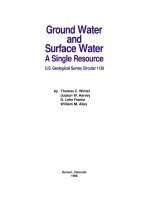Applied Colloid and surface chemistry
Bạn đang xem bản rút gọn của tài liệu. Xem và tải ngay bản đầy đủ của tài liệu tại đây (4.94 MB, 190 trang )
Applied Colloid
and
Surface Chemistry
Applied Colloid and Surface Chemistry Richard M. Pashley and Marilyn E. Karaman
© 2004 John Wiley & Sons, Ltd. ISBN 0 470 86882 1 (HB) 0 470 86883 X (PB)
Applied Colloid
and
Surface Chemistry
Richard M. Pashley and Marilyn E. Karaman
Department of Chemistry, The National University of
Australia, Canberra, Australia
Copyright © 2004 John Wiley & Sons Ltd, The Atrium, Southern Gate, Chichester,
West Sussex PO19 8SQ, England
Telephone (+44) 1243 779777
Email (for orders and customer service enquiries):
Visit our Home Page on www.wileyeurope.com or www.wiley.com
All Rights Reserved. No part of this publication may be reproduced, stored in a retrieval
system or transmitted in any form or by any means, electronic, mechanical, photocopying,
recording, scanning or otherwise, except under the terms of the Copyright, Designs and Patents
Act 1988 or under the terms of a licence issued by the Copyright Licensing Agency Ltd, 90
Tottenham Court Road, London W1T 4LP, UK, without the permission in writing of the
Publisher. Requests to the Publisher should be addressed to the Permissions Department, John
Wiley & Sons Ltd, The Atrium, Southern Gate, Chichester, West Sussex PO19 8SQ, England,
or emailed to , or faxed to (+44) 1243 770620.
This publication is designed to provide accurate and authoritative information in regard to the
subject matter covered. It is sold on the understanding that the Publisher is not engaged in
rendering professional services. If professional advice or other expert assistance is required, the
services of a competent professional should be sought.
Other Wiley Editorial Offices
John Wiley & Sons Inc., 111 River Street, Hoboken, NJ 07030, USA
Jossey-Bass, 989 Market Street, San Francisco, CA 94103-1741, USA
Wiley-VCH Verlag GmbH, Boschstr. 12, D-69469 Weinheim, Germany
John Wiley & Sons Australia Ltd, 33 Park Road, Milton, Queensland 4064, Australia
John Wiley & Sons (Asia) Pte Ltd, 2 Clementi Loop # 02-01, Jin Xing Distripark, Singapore
129809
John Wiley & Sons Canada Ltd, 22 Worcester Road, Etobicoke, Ontario, Canada M9W 1L1
Wiley also publishes its books in a variety of electronic formats. Some content that appears in
print may not be available in electronic books.
Library of Congress Cataloging-in-Publication Data
Pashley, Richard M.
Applied colloid and surface chemistry / Richard M. Pashley and Marilyn E. Karaman.
p. cm.
Includes bibliographical references and index.
ISBN 0 470 86882 1 (cloth : alk. paper) — ISBN 0 470 86883 X (pbk. : alk. paper)
1. Colloids. 2. Surface chemistry. I. Karaman, Marilyn E. II. Title.
QD549.P275 2004
541¢.345 — dc22
2004020586
British Library Cataloguing in Publication Data
A catalogue record for this book is available from the British Library
ISBN 0 470 86882 1 Hardback
0 470 86883 X Paperback
Typeset in 11/13
1
/
2
pt Sabon by SNP Best-set Typesetter Ltd., Hong Kong
Printed and bound in Great Britain by TJ International Ltd, Padstow, Cornwall
This book is printed on acid-free paper responsibly manufactured from sustainable forestry in
which at least two trees are planted for each one used for paper production.
Those that can, teach
Sit down before fact as a little child, be prepared
to give up every preconceived notion, follow
humbly wherever and to whatever abysses nature
leads, or you shall learn nothing.
Thomas Henry Huxley (1860)
Contents
Preface xi
1 Introduction 1
Introduction to the nature of colloidal solutions 1
The forces involved in colloidal stability 4
Types of colloidal systems 5
The link between colloids and surfaces 6
Wetting properties and their industrial importance 8
Recommended resource books 10
Appendices 11
2 Surface Tension and Wetting 13
The equivalence of the force and energy description of surface tension
and surface energy 13
Derivation of the Laplace pressure equation 15
Methods for determining the surface tension of liquids 17
Capillary rise and the free energy analysis 21
The Kelvin equation 24
The surface energy and cohesion of solids 27
The contact angle 28
Industrial Report: Photographic-quality printing 33
Sample problems 35
Experiment 2.1: Rod in free surface (RIFS) method for the
measurement of the surface tension of liquids 37
Experiment 2.2: Contact angle measurements 42
3 Thermodynamics of Adsorption 47
Basic surface thermodynamics 47
Derivation of the Gibbs adsorption isotherm 49
Determination of surfactant adsorption densities 52
Industrial Report: Soil microstructure, permeability and
interparticle forces 54
Sample problems 55
Experiment 3.1: Adsorption of acetic acid on to activated charcoal 56
4 Surfactants and Self-assembly 61
Introduction to surfactants 61
Common properties of surfactant solutions 63
Thermodynamics of surfactant self-assembly 65
Self-assembled surfactant structures 68
Surfactants and detergency 70
Industrial Report: Colloid science in detergency 74
Sample problems 75
Experiment 4.1: Determination of micelle ionization 75
5 Emulsions and Microemulsions 79
The conditions required to form emulsions and microemulsions 79
Emulsion polymerization and the production of latex paints 81
Photographic emulsions 84
Emulsions in food science 85
Industrial Report: Colloid science in foods 85
Experiment 5.1: Determination of the phase behaviour of
microemulsions 87
Experiment 5.2: Determination of the phase behaviour of
concentrated surfactant solutions 90
6 Charged Colloids 93
The formation of charged colloids in water 93
The theory of the diffuse electrical double-layer 94
The Debye length 99
The surface charge density 101
The zeta potential 102
The Hückel equation 103
The Smoluchowski equation 106
Corrections to the Smoluchowski equation 108
The zeta potential and flocculation 110
The interaction between double-layers 112
The Derjaguin approximation 116
Industrial Report: The use of emulsions in coatings 117
Sample problems 119
Experiment 6.1: Zeta potential measurements at the silica/
water interface 120
7 Van der Waals forces and Colloid Stability 127
Historical development of van der Waals forces and the
Lennard-Jones potential 127
viii CONTENTS
Dispersion forces 131
Retarded forces 132
Van der Waals forces between macroscopic bodies 133
Theory of the Hamaker constant 134
Use of Hamaker constants 140
The DLVO theory of colloid stability 140
Flocculation 142
Some notes on van der Waals forces 148
Industrial Report: Surface chemistry in water treatment 148
Sample problems 150
8 Bubble coalescence, Foams and Thin Surfactant Films 153
Thin-liquid-film stability and the effects of surfactants 153
Thin-film elasticity 156
Repulsive forces in thin liquid films 157
Froth flotation 158
The Langmuir trough 159
Langmuir–Blodgett films 166
Experiment 8.1: Flotation of powdered silica 168
Appendices 173
1 Useful Information 173
2 Mathematical Notes on the Poisson–Boltzmann Equation 175
3 Notes on Three-dimensional Differential Calculus and the
Fundamental Equations of Electrostatics 179
Index 181
CONTENTS ix
Preface
This book was written following several years of teaching this mate-
rial to third-year undergraduate and honours students in the Depart-
ment of Chemistry at the Australian National University in Canberra,
Australia. Science students are increasingly interested in the application
of their studies to the real world and colloid and surface chemistry is
an area that offers many opportunities to apply learned understanding
to everyday and industrial examples. There is a lack of resource mate-
rials with this focus and so we have produced the first edition of this
book. The book is intended to take chemistry or physics students with
no background in the area, to the level where they are able to under-
stand many natural phenomena and industrial processes, and are able
to consider potential areas of new research. Colloid and surface chem-
istry spans the very practical to the very theoretical, and less mathe-
matical students may wish to skip some of the more involved deriva-
tions. However, they should be able to do this and still maintain a good
basic understanding of the fundamental principles involved. It should
be remembered that a thorough knowledge of theory can act as a
barrier to progress, through the inhibition of further investigation. Stu-
dents asking ignorant but intelligent questions can often stimulate valu-
able new research areas.
The book contains some recommended experiments which we have
found work well and stimulate students to consider both the funda-
mental theory and industrial applications. Sample questions have also
been included in some sections, with detailed answers available on our
web site.
Although the text has been primarily aimed at students, researchers
in cognate areas may also find some of the topics stimulating. A rea-
sonable background in chemistry or physics is all that is required.
1
Introduction
Applied Colloid and Surface Chemistry Richard M. Pashley and Marilyn E. Karaman
© 2004 John Wiley & Sons, Ltd. ISBN 0 470 86882 1 (HB) 0 470 86883 X (PB)
Introduction to the nature of colloids and the linkage between col-
loids and surface properties. The importance of size and surface area.
Introduction to wetting and the industrial importance of surface
modifications.
Introduction to the nature of
colloidal solutions
The difference between macroscopic and microscopic objects is clear
from everyday experience. For example, a glass marble will sink rapidly
in water; however, if we grind it into sub-micron-sized particles, these
will float or disperse freely in water, producing a visibly cloudy ‘solu-
tion’, which can remain stable for hours or days. In this process we
have, in fact, produced a ‘colloidal’ dispersion or solution. This dis-
persion of one (finely divided or microscopic) phase in another is quite
different from the molecular mixtures or ‘true’ solutions formed when
we dissolve ethanol or common salt in water. Microscopic particles of
one phase dispersed in another are generally called colloidal solutions
or dispersions. Both nature and industry have found many uses for this
type of solution. We will see later that the properties of colloidal solu-
tions are intimately linked to the high surface area of the dispersed
phase, as well as to the chemical nature of the particle’s surface.
Historical note: The term ‘colloid’ is derived from the Greek word
‘kolla’ for glue. It was originally used for gelatinous polymer colloids,
which were identified by Thomas Graham in 1860 in experiments on
osmosis and diffusion.
It turns out to be very useful to dissolve (or more strictly disperse)
solids, such as minerals and metals, in water. But how does it happen?
We can see why from simple physics. Three fundamental forces operate
on fine particles in solution:
(1) a gravitational force, tending to settle or raise particles depending
on their density relative to the solvent;
(2) a viscous drag force, which arises as a resistance to motion, since
the fluid has to be forced apart as the particle moves through it;
(3) the ‘natural’ kinetic energy of particles and molecules, which
causes Brownian motion.
If we consider the first two forces, we can easily calculate the termi-
nal or limiting velocity, V, (for settling or rising, depending on the par-
ticle’s density relative to water) of a spherical particle of radius r. Under
these conditions, the viscous drag force must equal the gravitational
force. Thus, at a settling velocity, V, the viscous drag force is given by:
F
drag
= 6prVh=4pr
3
g(r
p
-r
w
)/3 = F
gravity
, the gravitational force, where
h is the viscosity of water and the density difference between particle
and water is (r
p
-r
w
). Hence, if we assume a particle–water density
difference of +1gcm
-3
, we obtain the results:
r (Å) 100 1000 10000 10
5
10
6
r (mm) 0.01 0.1 1 10 100
V (cms
-1
)2 ¥ 10
-8
2 ¥ 10
-6
2 ¥ 10
-4
2 ¥ 10
-2
2
2
INTRODUCTION
Clearly, from factors (1) and (2), small particles will take a very long
time to settle and so a fine dispersion will be stable almost indefinitely,
even for materials denser than water. But what of factor (3)? Each par-
ticle, independent of size, will have a kinetic energy, on average, of
around 1kT. So the typical, random speed (v) of a particle (in any direc-
tion) will be roughly given by:
Again, if we assume that r
p
= 2gcm
-3
, then we obtain the results:
r (Å) 100 1000 10000 10
5
10
6
r (mm) 0.01 0.1 1 10 100
v (cms
-1
)10
2
3 0.1 3 ¥ 10
-3
1 ¥ 10
-4
These values suggest that kinetic random motion will dominate the
behaviour of small particles, which will not settle and the dispersion
will be completely stable. However, this point is really the beginning of
‘colloid science’. Since these small particles have this kinetic energy they
will, of course, collide with other particles in the dispersion, with col-
lision energies ranging up to at least 10kT (since there will actually be
a distribution of kinetic energies). If there are attractive forces between
the particles – as is reasonable since most colloids were initially formed
via a vigorous mechanical process of disruption of a macroscopic or
large body – each collision might cause the growth of large aggregates,
which will then, for the reasons already given, settle out, and we will
no longer have a stable dispersion! The colloidal solution will coagu-
late and produce a solid precipitate at the bottom of a clear solution.
There is, in fact, a ubiquitous force in nature, called the van der
Waals force (vdW), which is one of the main forces acting between mol-
ecules and is responsible for holding together many condensed phases,
such as solid and liquid hydrocarbons and polymers. It is responsible
for about one third of the attractive force holding liquid water mole-
cules together. This force was actually first observed as a correction to
the ideal gas equation and is attractive even between neutral gas mol-
ecules, such as oxygen and nitrogen, in a vacuum. Although electro-
magnetic in origin (as we will see later), it is much weaker than the
Coulombic force acting between ions.
mv kT
221
21 410@@¥
(
)
-
J at room temperature
INTRODUCTION TO THE NATURE OF COLLOIDAL SOLUTIONS 3
The forces involved in colloidal stability
Although van der Waals forces will always act to coagulate dispersed
colloids, it is possible to generate an opposing repulsive force of com-
parable strength. This force arises because most materials, when dis-
persed in water, ionize to some degree or selectively adsorb ions from
solution and hence become charged. Two similarly charged colloids will
repel each other via an electrostatic repulsion, which will oppose coag-
ulation. The stability of a colloidal solution is therefore critically
dependent on the charge generated at the surface of the particles. The
combination of these two forces, attractive van der Waals and repul-
sive electrostatic forces, forms the fundamental basis for our under-
standing of the behaviour and stability of colloidal solutions. The cor-
responding theory is referred to as the DLVO (after Derjaguin, Landau,
Verwey and Overbeek) theory of colloid stability, which we will con-
sider in greater detail later. The stability of any colloidal dispersion is
thus determined by the behaviour of the surface of the particle via its
surface charge and its short-range attractive van der Waals force.
Our understanding of these forces has led to our ability to selectively
control the electrostatic repulsion, and so create a powerful mechanism
for controlling the properties of colloidal solutions. As an example, if
we have a valuable mineral embedded in a quartz rock, grinding the
rock will both separate out pure, individual quartz and the mineral par-
ticles, which can both be dispersed in water. The valuable mineral can
then be selectively coagulated, whilst leaving the unwanted quartz in
solution. This process is used widely in the mining industry as the first
stage of mineral separation. The alternative of chemical processing, for
example, by dissolving the quartz in hydrofluoric acid, would be both
expensive and environmentally unfriendly.
It should be realized, at the outset, that colloidal solutions (unlike
true solutions) will almost always be in a metastable state. That is, an
electrostatic repulsion prevents the particles from combining into their
most thermodynamically stable state, of aggregation into the macro-
scopic form, from which the colloidal dispersion was (artificially)
created in the first place. On drying, colloidal particles will often remain
separated by these repulsive forces, as illustrated by Figure 1.1, which
shows a scanning electron microscope picture of mono-disperse silica
colloids.
4 INTRODUCTION
Types of colloidal systems
The term ‘colloid’ usually refers to particles in the size range 50Å to
50mm but this, of course, is somewhat arbitrary. For example, blood
could be considered as a colloidal solution in which large blood cells
are dispersed in water. Often we are interested in solid dispersions in
aqueous solution but many other situations are also of interest and
industrial importance. Some examples are given in Table 1.1.
TYPES OF COLLOIDAL SYSTEMS 5
Figure 1.1 Scanning electron microscope image of dried, mono-
disperse silica colloids.
Table 1.1
Dispersed Dispersion Name Examples
phase medium
Liquid Gas Liquid aerosol Fogs, sprays
Solid Gas Solid aerosol Smoke, dust
Gas Liquid Foam Foams
Liquid Liquid Emulsion Milk, Mayonnaise
Solid Liquid ‘Sol’ or colloidal solution Au sol, AgI sol
Paste at high concentration Toothpaste
Gas Solid Solid foam Expanded polystyrene
Liquid Solid Solid emulsion Opal, pearl
Solid Solid Solid suspension Pigmented plastics
The properties of colloidal dispersions are intimately linked to the
high surface area of the dispersed phase and the chemistry of these
interfaces. This linkage is well illustrated by the titles of two of the
main journals in this area: the Journal of Colloid and Interface Science
and Colloids and Surfaces. The natural combination of colloid and
surface chemistry represents a major area of both research activity and
industrial development. It has been estimated that something like 20
per cent of all chemists in industry work in this area.
The link between colloids and surfaces
The link between colloids and surfaces follows naturally from the fact
that particulate matter has a high surface area to mass ratio. The
surface area of a 1cm diameter sphere (4pr
2
) is 3.14cm
2
, whereas the
surface area of the same amount of material but in the form of 0.1mm
diameter spheres (i.e. the size of the particles in latex paint) is
314000 cm
2
. The enormous difference in surface area is one of the
reasons why the properties of the surface become very important for
colloidal solutions. One everyday example is that organic dye mole-
cules or pollutants can be effectively removed from water by adsorp-
tion onto particulate activated charcoal because of its high surface area.
This process is widely used for water purification and in the oral treat-
ment of poison victims.
Although it is easy to see that surface properties will determine the
stability of colloidal dispersions, it is not so obvious why this can also
6 INTRODUCTION
be the case for some properties of macroscopic objects. As one impor-
tant illustration, consider Figure 1.2, which illustrates the interface
between a liquid and its vapour. Molecules in the bulk of the liquid can
interact via attractive forces (e.g. van der Waals) with a larger number
of nearest neighbours than those at the surface. The molecules at the
surface must therefore have a higher energy than those in bulk, since
they are partially freed from bonding with neighbouring molecules.
Thus, work must be done to take fully interacting molecules from the
bulk of the liquid to create any new surface. This work gives rise to
the surface energy or tension of a liquid. Hence, the stronger the inter-
molecular forces between the liquid molecules, the greater will this
work be, as is illustrated in Table 1.2.
The influence of this surface energy can also be clearly seen on the
macroscopic shape of liquid droplets, which in the absence of all other
forces will always form a shape of minimum surface area – that is, a
sphere in a gravity-free system. This is the reason why small mercury
droplets are always spherical.
THE LINK BETWEEN COLLOIDS AND SURFACES 7
Figure 1.2 Schematic diagram to illustrate the complete bonding of
liquid molecules in the bulk phase but not at the surface.
Table 1.2
Liquid Surface energy in mJm
-2
Type of intermolecular
(at 20°C) bonding
Mercury 485 metallic
Water 72.8 hydrogen bonding + vdW
n-Octanol 27.5 hydrogen bonding + vdW
n-Hexane 18.4 vdW
Perfluoro-octane 12 weak vdW
Wetting properties and their
industrial importance
Although a liquid will always try to form a minimum-surface-area
shape, if no other forces are involved, it can also interact with other
macroscopic objects, to reduce its surface tension via molecular
bonding to another material, such as a suitable solid. Indeed, it may be
energetically favourable for the liquid to interact and ‘wet’ another
material. The wetting properties of a liquid on a particular solid are
very important in many everyday activities and are determined solely
by surface properties. One important and common example is that of
water on clean glass. Water wets clean glass (Figure 1.3) because of the
favourable hydrogen bond interaction between the surface silanol
groups on glass and adjacent water molecules.
However, exposure of glass to Me
3
SiCl vapour rapidly produces a
0.5nm layer of methyl groups on the surface. These groups cannot
hydrogen-bond and hence water now does not wet and instead forms
high ‘contact angle’ (q) droplets and the glass now appears to be
hydrophobic, with water droplet beads similar to those observed on
paraffin wax (Figure 1.5).
This dramatic macroscopic difference in wetting behaviour is caused
by only a thin molecular layer on the surface of glass and clearly
demonstrates the importance of surface properties. The same type of
8 INTRODUCTION
H
HH
H
Si
Si
Si
H
O
O
O H
H
O H O
O
H
H O
H
Figure 1.3 Water molecules form hydrogen bonds with the silanol
groups at the surface of clean glass.
OO O
Si Si
Si
H
H
H
H
O
O
CH
3
CH
3
CH
3
CH
3
SiCH
3
CH
3
SiCH
3
CH
3
SiCH
3
Figure 1.4 Water molecules can only weakly interact (by vdw forces)
with a methylated glass surface.
effect occurs every day, when dirty fingers coat grease onto a drinking
glass! Surface treatments offer a remarkably efficient method for the
control of macroscopic properties of materials. When insecticides are
sprayed onto plant leaves, it is vital that the liquid wet and spread over
the surface. Another important example is the froth flotation technique,
used by industry to separate about a billion tons of ore each year.
Whether valuable mineral particles will attach to rising bubbles and be
‘collected’ in the flotation process, is determined entirely by the surface
properties or surface chemistry of the mineral particle, and this can be
controlled by the use of low levels of ‘surface-active’ materials, which
will selectively adsorb and change the surface properties of the mineral
particles. Very large quantities of minerals are separated simply by the
adjustment of their surface properties.
Although it is relatively easy to understand why some of the macro-
scopic properties of liquids, especially their shape, can depend on
surface properties, it is not so obvious for solids. However, the strength
of a solid is determined by the ease with which micro-cracks propa-
gate, when placed under stress, and this depends on its surface energy,
that is the amount of (surface) work required to continue the crack and
hence expose new surface. This has the direct effect that materials are
stronger in a vacuum, where their surface energy is not reduced by the
adsorption of either gases or liquids, typically available under atmos-
pheric conditions.
Many other industrial examples where colloid and surface chemistry
plays a significant role will be discussed later, these include:
• latex paint technology
• photographic emulsions
• soil science
• soaps and detergents
WETTING PROPERTIES AND THEIR INDUSTRIAL IMPORTANCE 9
methylated silica
vapour
water
q
Figure 1.5 A non-wetting water droplet on the surface of
methylated, hydrophobic silica.
• food science
• mineral processing.
Recommended resource books
Adamson, A.W. (1990) Physical Chemistry of Surfaces, 5th edn, Wiley, New
York
Birdi, K.S. (ed.) (1997) CRC Handbook of Surface and Colloid Chemistry,
CRC Press, Boca Raton, FL
Evans, D.F. and Wennerstrom, H. (1999) The Colloidal Domain, 2nd edn,
Wiley, New York
Hiemenz, P.C. (1997) Principles of Colloid and Surface Chemistry, 3rd edn,
Marcel Dekker, New York
Hunter, R.J. (1987) Foundations of Colloid Science, Vol. 1, Clarendon Press,
Oxford
Hunter, R.J. (1993) Introduction to Modern Colloid Science, Oxford Sci.
Publ., Oxford
Israelachvili, J.N. (1985) Intermolecular and Surface Forces, Academic Press,
London
Shaw, D.J. (1992) Introduction to Colloid and Surface Chemistry, 4th edn,
Butterworth-Heinemann, Oxford, Boston
10 INTRODUCTION
Appendices
A Some historical notes on colloid and surface chemistry
Robert Hooke (1661) investigates capillary rise.
John Freind at Oxford (1675–1728) was the first person to realize that inter-
molecular forces are of shorter range than gravity.
Young (1805) estimated range of intermolecular forces at about 0.2 nm. Turns
out to be something of an underestimate.
Young and Laplace (1805) derived meniscus curvature equation.
Brown (1827) observed the motion of fine particles in water.
Van der Waals (1837–1923) was a schoolmaster who produced a doctoral
thesis on the effects of intermolecular forces on the properties of gases (1873).
Graham (1860) had recognized the existence of colloids in the mid 19th
century.
Faraday (1857) made colloidal solutions of gold.
Schulze and Hardy (1882–1900) studied the effects of electrolytes on colloid
stability.
Perrin (1903) used terms ‘lyophobic’ and ‘lyophilic’ to denote irreversible and
reversible coagulation.
Ostwald (1907) developed the concepts of ‘disperse phase’ and ‘dispersion
medium’.
Gouy and Chapman (1910–13) independently used the Poisson–
Boltzmann equations to describe the diffuse electrical double-layer formed at
the interface between a charged surface and an aqueous solution.
Ellis and Powis (1912–15) introduced the concept of the critical zeta poten-
tial for the coagulation of colloidal solutions.
Fritz London (1920) first developed a theoretical basis for the origin of inter-
molecular forces.
Debye (1920) used polarizability of molecules to estimate attractive forces.
Debye and Hückel (1923) used a similar approach to Gouy and Chapman to
calculate the activity coefficients of electrolytes.
Stern (1924) introduced the concept of specific ion adsorption at surfaces.
Kallmann and Willstätter (1932) calculated van der Waals force between col-
loidal particles using the summation procedure and suggested that a complete
APPENDICES 11
picture of colloid stability could be obtained on the basis of electrostatic
double-layer and van der Waals forces.
Bradley (1932) independently calculated van der Waals forces between col-
loidal particles.
Hamaker (1932) and de Boer (1936) calculated van der Waals forces between
macroscopic bodies using the summation method.
Derjaguin and Landau, and Verwey and Overbeek (1941–8) developed the
DLVO theory of colloid stability.
Lifshitz (1955–60) developed a complete quantum electrodynamic (contin-
uum) theory for the van der Waals interaction between macroscopic bodies.
B Dispersed particle sizes
12 INTRODUCTION
metres
10
–4
10
–5
10
–6
10
–7
10
–8
10
–9
10
–10
100 10 1 0.1 10
–2
10
–3
10
–4
m
m
10
6
10
5
10
4
1000 100 10 1 Å
colloidal
molecules
mist fog
macromolecules
oil smoke
pollen bacteria
virus
micelles
2
Surface Tension
and Wetting
Applied Colloid and Surface Chemistry Richard M. Pashley and Marilyn E. Karaman
© 2004 John Wiley & Sons, Ltd. ISBN 0 470 86882 1 (HB) 0 470 86883 X (PB)
The equivalence of the force and energy description of surface
tension and surface energy. Derivation of the Laplace pressure and a
description of common methods for determining the surface tension
of liquids. The surface energy and cohesion of solids, liquid wetting
and the liquid contact angle. Laboratory projects for measuring the
surface tension of liquids and liquid contact angles.
The equivalence of the force and energy
description of surface tension and
surface energy
It is easy to demonstrate that the surface energy of a liquid actually
gives rise to a ‘surface tension’ or force acting to oppose any increase
in surface area. Thus, we have to ‘blow’ to create a soap bubble by
stretching a soap film. A spherical soap bubble is formed in response
to the tension in the bubble surface (Figure 2.1). The soap film shows
interference colours at the upper surface, where the film is starting to
thin, under the action of gravity, to thicknesses of the order of the wave-
length of light. Some beautiful photographs of various types of soap
films are given in The Science of Soap Films and Soap Bubbles by
C. Isenberg (1992).
If we stretch a soap film on a wire frame, we find that we need to
apply a significant, measurable force, F, to prevent collapse of the film
(Figure 2.2). The magnitude of this force can be obtained by consider-
ation of the energy change involved in an infinitesimal movement of
the cross-bar by a distance dx, which can be achieved by doing
reversible work on the system, thus raising its free energy by a small
amount Fdx. If the system is at equilibrium, this change in (free) energy
must be exactly equal to the increase in surface (free) energy (2dxlg)
associated with increasing the area of both surfaces of the soap film.
Hence, at equilibrium:
(2.1)
or
(2.2)
It is precisely this, that work has to be done to increase a liquid’s surface
area, that makes the surface of a liquid behave like a stretched skin,
g=Fl2
Fx xldd= 2 g
14 SURFACE TENSION AND WETTING
Figure 2.1 Photograph of a soap bubble.
hence the term ‘surface tension’. It is this tension that allows a water
boatman insect to travel freely on the surface of a pond, locally deform-
ing the skin-like surface of the water.
This simple experimental system clearly demonstrates the equiva-
lence of surface energy and tension. The dimensions of surface energy,
mJm
-2
, are equivalent to those of surface tension, mNm
-1
. For pure
water, an energy of about 73mJ is required to create a 1m
2
area of new
surface. Assuming that one water molecule occupies an area of roughly
12Å
2
, the free energy of transfer of one molecule of water from bulk
to the surface is about 3kT (i.e. 1.2 ¥ 10
-20
J), which compares with
roughly 8kT per hydrogen bond. The energy or work required to create
new water–air surface is so crucial to a newborn baby that nature has
developed lung surfactants specially to reduce this work by about a
factor of three. Premature babies often lack this surfactant and it has
to be sprayed into their lungs to help them breathe.
Derivation of the Laplace pressure equation
Since it is relatively easy to transfer molecules from bulk liquid to the
surface (e.g. shake or break up a droplet of water), the work done in
this process can be measured and hence we can obtain the value of the
surface energy of the liquid. This is, however, obviously not the case
for solids (see later section). The diverse methods for measuring surface
and interfacial energies of liquids generally depend on measuring either
the pressure difference across a curved interface or the equilibrium
(reversible) force required to extend the area of a surface, as above.
The former method uses a fundamental equation for the pressure
generated across any curved interface, namely the Laplace equation,
which is derived in the following section.
DERIVATION OF THE LAPLACE PRESSURE EQUATION 15
l
F
dx
Wire frame
Thick
soap film
Figure 2.2 Diagram of a soap film stretched on a wire frame.
Let us consider the conditions under which an air bubble (i.e. a
curved surface) is stable. Consider the case of an air bubble produced
in water by blowing through a tube (Figure 2.3). Obviously, to blow
the air bubble we must have applied a higher pressure, P
I
, inside the
bubble, compared with the external pressure in the surrounding water
(P
O
). The bubble will be stable when there is no net air flow, in or out,
and the bubble radius stays constant. Under these, equilibrium,
conditions there will be no free energy change in the system for any
infinitesimal change in the bubble radius, that is, dG/dr = 0, where dr
is an infinitesimal decrease in bubble radius. If the bubble were to
collapse by a small amount dr, the surface area of the bubble will be
reduced, giving a decrease in the surface free energy of the system. The
only mechanism by which this change can be prevented is to raise the
pressure inside the bubble so that P
I
> P
O
and work has to be done to
reduce the bubble size. The bubble will be precisely at equilibrium when
the change in free energy due to a reduced surface area is balanced by
this work. For an infinitesimal change, dr, the corresponding free
energy change of this system is given by the sum of the decrease in
surface free energy and the mechanical work done against the pressure
difference across the bubble surface, thus:
(2.3)
(2.4)
(ignoring higher-order terms). At equilibrium dG/dr = 0 and hence:
(2.5)
-+ =840
2
pg prPrD
=- +84
2
pg prr P r rddD
ddd
IO
GrrrPPrr=- - -
(
)
{}
+-
(
)
gp p p44 4
2
2
2
16 SURFACE TENSION AND WETTING
water
P
O
P
I
r
dr
air
Figure 2.3 Diagram of a spherical air bubble in water.









